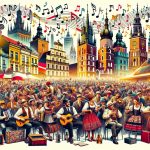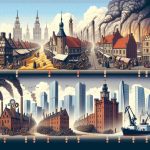
Poland has a fascinating history and culture, full of ups and downs. It’s a country that’s been through a lot, from its early days, through periods when it was divided by other countries, the huge impact of World War II, to the big changes after communism ended.
There are lots of books out there that dive into these different parts of Poland’s story, showing us how the country and its people have survived and changed over time. So, what are some of the best books that really get into the heart of Poland’s history and its lively culture today?
Let’s take a look at some must-reads that give us a deep understanding of this unique country at the heart of Europe.
Foundations of Polish History
Polish history is a rich blend of Slavic traditions, key geographic positioning, and evolving political systems. It all began in the 10th century with the Piast dynasty, which played a crucial role in introducing Christianity to Poland. This move was not just about religion; it significantly shaped Poland’s culture and politics. During this time, Poland started to form a unique identity within the larger Slavic community. Researchers focus on this period to understand how Poland dealt with internal growth and external threats. They show us that early Poland was adept at expanding its territory, integrating new areas, and protecting itself from invasions from both the East and the West. These actions laid the groundwork for the complex history that would unfold in the following centuries.
Let’s break this down further. The Piast dynasty’s decision to adopt Christianity in the late 10th century was a game-changer. It opened up Poland to Western influences, helping it forge alliances and shape its identity distinct from other Slavic nations. This period is fascinating because it shows the strategic thinking of Poland’s early rulers. They weren’t just trying to expand their land; they were building a nation.
One concrete example of how Poland navigated its challenges is its relationship with the Holy Roman Empire and the Byzantine Empire. Poland skillfully maneuvered between these two powers, adopting Western Christianity while also engaging in diplomacy with the Eastern Orthodox world. This balancing act helped Poland protect its interests and grow stronger.
For those interested in delving deeper into this era, I recommend reading “The Making of Poland: Piast Dynasty and the Birth of a Nation” by historian Anna Zieminska. This book provides a detailed account of how Poland’s foundations were laid, including vivid accounts of battles, alliances, and the strategic decisions that shaped the early Polish state.
The Partitions Era Explored
Following the era dominated by the Piast dynasty, Poland entered a challenging phase known as the partitions era. This time, running from the late 18th century to the early 20th century, saw Poland’s lands divided among the Russian Empire, the Kingdom of Prussia, and the Habsburg Monarchy through three significant events in 1772, 1793, and 1795. These divisions wiped Poland off the map of Europe, plunging its people into a deep identity crisis.
Experts studying this period focus on the social and political reasons behind these partitions. They reveal how the Enlightenment, a movement emphasizing reason and individualism, influenced Polish efforts to modernize and reform. Despite these efforts, the country struggled against its more powerful neighbors. This struggle sparked a wave of nationalism among the Polish people, a desire to reclaim their country and preserve their unique identity.
For anyone interested in understanding this era better, I recommend reading ‘The Partitions of Poland: Loyalty, Identity, and Nationality in the Eighteenth Century’ by Jerzy Lukowski. This book offers a detailed exploration of the partitions, providing insights into the complex interplay of forces that led to Poland’s division.
World War II Through Polish Eyes
Looking at World War II from the perspective of Poland opens up a new window into this catastrophic event in history. It brings to light the severe consequences and permanent marks it left on Poland and its citizens. From this viewpoint, we see not just the harsh occupation by Nazi Germany and the Soviet Union, but also the courageous efforts of the Polish resistance.
Diving deeper, this perspective uncovers the intricate relationship between Poles and Jews during the Holocaust. It brings attention to the tragic events of the Warsaw Uprising and the painful aftermath, including the redrawing of Poland’s borders and the profound changes to its community structure. By focusing on these aspects, we gain a fuller understanding of the intense challenges the Polish people endured, the ethical quandaries they faced under occupation, and how these experiences have forever influenced Poland’s national identity and cultural essence.
For example, the story of the Warsaw Uprising in 1944 showcases the bravery of the Polish resistance fighters. Despite being under-equipped and outnumbered, they fought valiantly against the German forces in an effort to liberate their city. This act of bravery, though ending in tragedy with the destruction of Warsaw and loss of thousands of lives, remains a powerful testament to the Polish spirit of resistance.
Another aspect worth noting is the complex Polish-Jewish relations during this time. The situation varied widely across the country, with instances of both solidarity and betrayal. The creation of the Żegota organization, a Polish council to aid Jews, is a prime example of Poles risking their lives to help their Jewish neighbors.
Through discussing these points in a clear and conversational manner, we aim to make this part of history more accessible and understandable. By highlighting specific examples and explaining their significance, we hope to provide a richer, more detailed picture of World War II’s impact on Poland. This approach not only honors the memory of those who suffered but also educates and engages readers by bringing history to life in a relatable way.
Post-Communist Transformation
Poland underwent a significant transformation after the fall of communism, moving from an economy controlled by the government to one driven by market forces. This change was a massive shift, bringing about major political, social, and economic adjustments. The process, often called ‘shock therapy,’ involved quickly moving to privatize businesses that the state used to own, freeing up prices to be determined by the market, and setting up democratic institutions. Experts have thoroughly studied the effects of these reforms. They point out that while Poland’s economy grew faster, not everyone benefited equally – social inequality rose.
In exploring this era, researchers focus on how new capitalist practices interacted with old socialist habits. This mix shaped Poland’s journey to join the European Union fully. They look into how Polish society managed to adapt to these big changes, facing challenges but also finding successes. For example, the rapid growth of small businesses and the increase in foreign investment were clear indicators of economic progress. Meanwhile, the struggle of some communities to adapt to the new economic realities highlighted the uneven impact of the transition.
The conversation around Poland’s transformation is not just about numbers and policies. It’s about the real experiences of people who lived through it. It’s about the workers who had to learn new skills for a changing job market, the entrepreneurs who took risks to start new businesses, and the everyday citizens who navigated the ups and downs of a society in flux. These stories add depth and color to our understanding of what it meant for Poland to shift from communism to a market economy.
Modern Polish Culture and Society
Poland’s culture and society have seen significant changes recently, mixing its rich history with new, modern influences. This change is largely because of global connections and Poland’s closer ties with Europe. When we look into modern Polish culture and society, we find a complex story of how people are shaping their identity today. This story takes into account Poland’s past, like the Communist era and the Solidarity movement, but also looks at current issues such as migration, the rise of digital media, and political divides.
One key area of interest is how Polish media, arts, and literature are adapting. Many studies show that cultural institutions and community initiatives are crucial in bridging the gap between old traditions and new ideas. For example, in literature, there’s a noticeable shift towards themes that reflect contemporary life in Poland, including the impact of technology and social media. In the arts, there’s a vibrant scene that ranges from traditional crafts to modern installations that comment on societal issues.
The dialogue between the past and the present in Poland is not always smooth. Tensions arise, for instance, in debates over national identity or in the struggle to balance traditional values with a more inclusive view of society. Yet, these discussions are essential for understanding the direction in which Polish society is heading.
A concrete example of this cultural evolution can be seen in the film industry. Polish cinema has gained international acclaim for its thoughtful storytelling and exploration of both historical and modern themes. Movies like ‘Ida’ and ‘Cold War’ have not only received critical acclaim worldwide but also sparked conversations within Poland about its history and identity.
Conclusion
To wrap it up, diving into Polish history and culture lets us truly grasp the country’s rich story and lively present.
We start from the very beginning, move through tough times like the partitions, the heartbreak of World War II, then onto the changes after communism, and finally where Poland stands today.
Each topic gives us key insights, helping us see how Poland navigated its unique journey.
This isn’t just about knowing more about Poland; it’s about understanding how a nation stays strong, keeps its identity, and evolves.
So, in simple terms, studying Poland’s past and present teaches us a lot, not just about Poland, but about the strength and growth of cultures in general.






Comments are closed.